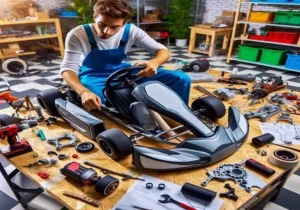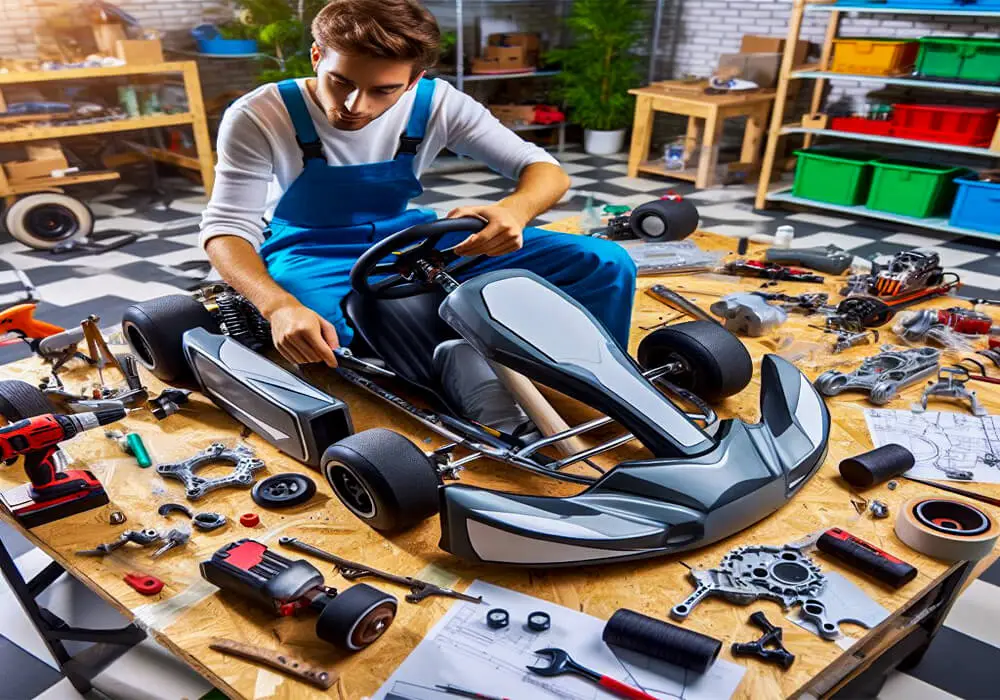How to make a fiberglass go kart body?
Creating a custom fiberglass go kart body can be a rewarding project, giving your kart a unique and professional look.
This guide will walk you through the process, from planning and creating a mold to applying the fiberglass and finishing touches. By following these steps, you’ll be able to build a durable and visually appealing go-kart body.
Planning Your Design

Before you start building, it’s essential to have a clear design in mind. Sketch your go kart body on paper, considering the size and shape that will fit your kart frame. Pay attention to details like aerodynamics and aesthetics.
Creating the Mold
Materials Needed
- Plywood
- Drywall compound
- Sandpaper
- Screws and nails
- Car wax or mold release wax
Step-by-Step Guide
Build the Basic Frame:
Construct the basic shape of your mold using plywood. This structure will serve as the skeleton of your mold.
Shape the Details:
Use drywall compound to refine the shape and add details. Apply the compound in thin layers, allowing each to dry before adding the next. Sand between layers to achieve a smooth finish.
Angle the Sides:
Ensure the sides of your mold have a slight angle (draft) to make it easier to remove the fiberglass body once it has cured. Avoid any undercuts, which can trap the fiberglass in the mold.
Finish the Mold:
Once you are satisfied with the shape, sand the entire surface smooth. Apply several coats of car wax or mold release wax to the inside of the mold to prevent the fiberglass from sticking.
Laying the Fiberglass
Materials Needed
- Fiberglass mat or cloth
- Polyester resin
- Hardener (activator)
- Disposable brushes
- Mixing containers
- Scissors
- Roller or squeegee
Step-by-Step Guide
1. Prepare the Resin:
Mix the polyester resin with the hardener according to the manufacturer’s instructions. Work in small batches to prevent the resin from hardening before you can use it.
2. Apply the First Layer:
Brush a thin layer of resin onto the mold. Lay the first layer of fiberglass mat over the resin. Use a roller or squeegee to remove any air bubbles and ensure the mat is fully saturated with resin.
3. Build Up Layers:
Repeat the process for at least three layers of fiberglass. Each layer should be fully saturated with resin and free of air bubbles. Allow the resin to cure for 24 hours.
4. Trim the Edges:
Once the fiberglass has cured, trim any excess material from the edges using a utility knife or saw.
Removing the Body from the Mold
Carefully separate the fiberglass body from the mold. Start at one edge and work slowly to avoid damaging the body. If necessary, use an air compressor to help release the body from the mold by blowing air into small holes drilled in the mold.
Finishing Touches
Filling and Sanding:
Inspect the fiberglass body for any imperfections, such as bubbles or rough spots. Fill these areas with body filler and sand smooth. Wet sanding with fine-grit sandpaper can help achieve a smooth, even surface.
Priming and Painting:
Apply a coat of automotive primer to the entire body. Once the primer is dry, sand it lightly to remove any imperfections. Then, apply your chosen paint color using a spray gun for a professional finish. Multiple thin coats will give the best results.
Mounting the Body:
Attach the finished fiberglass body to your go kart frame. Use bolts and brackets to secure it firmly in place. Make sure the body does not interfere with any moving parts or the driver’s comfort and safety.
Maintenance and Care
A fiberglass go kart body requires regular maintenance to keep it looking its best. Wash it with mild soap and water to remove dirt and grime. Wax the surface periodically to protect the paint and maintain its shine. Inspect the body for any cracks or damage and repair as needed to ensure its longevity.
FAQs
How do I design the shape of my go kart body?
Start by sketching your design on paper, focusing on the overall dimensions and contours of the go kart body. You can use a scale model to visualize the shape better. Once satisfied, translate these designs into 2D shapes for the front, back, and sides, which will guide your mold construction.
What is the purpose of the mold in fiberglass body construction?
The mold is used to shape the fiberglass into the desired form. It acts as a negative imprint of the body design. The fiberglass resin is applied over the mold, and once it hardens, it takes the shape of the mold, resulting in a solid go kart body.
How thick should the fiberglass layers be?
The fiberglass layers should be about 1/8 inch thick. Typically, this requires at least three layers of fiberglass cloth or matting to achieve the necessary strength and durability.
How long does it take for the fiberglass to cure?
After applying the fiberglass layers, you should let them cure for at least 24 hours. This allows the resin to harden completely, ensuring a strong and durable body.
Conclusion
Building a fiberglass go kart body is a challenging but rewarding project. By following this guide, you can create a custom body that not only enhances the look of your go kart but also improves its performance. Remember to prioritize safety and take your time with each step to achieve the best results. Enjoy your newly customized go kart!

